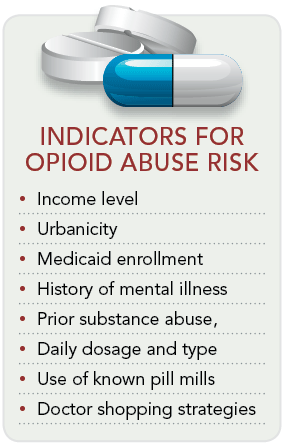We have heard the terms before: pill mills, oxy, perc, and othersuch slang for opioid drugs and their distributors. Each year,opioids kill more people than cocaine and heroin combined. Infact, nearly three out of four drug overdoses are caused byprescription pain killers, also called “opioid painrelievers.” 
The unprecedented rise in overdose deaths in the United Statesparallels a 300-percent increase since 1999 in the sale of thesestrong painkillers. The highly lucrative U.S. market for opioidsreached $1.5 billion in 2012, and opioids account for almost 30 percent of all prescription costs in theworkers' compensation claims. These opioids are derived fromopium poppy, or synthetic versions of it, and used for painrelief. Examples include hydrocodone (Vicodin), oxycodone(OxyContin) and fentanyl (Duragesic), methadone andcodeine.
|Opioid abuse drives a constellation of other healthcarecosts. Between 2004 and 2009, misuse and abuse of prescriptionpainkillers resulted in a doubling of emergency room visits, to475,000 annually.
|Enabling An Epidemic?
|As a claims organization, what steps can we take to reign in theepidemic of misuse and over-prescribing? After all, pain is a fact of injuryclaims and medical providers legally prescribe what they perceiveas the best treatment regimen for their patients. Perhaps.
|However, according to the CDC, most prescriptionpainkillers are being prescribed by primary care and internalmedicine doctors and dentists, ratherthan specialists. More significantly, 80 percent ofall prescription painkillers are coming from just 20percent of prescribers. This means that a small number ofgeneralists are driving enormous costs for payers and exposingtheir policyholders to significant addiction and injuryrisk. Given the statistically demonstrated risk posed byopioid pain relievers, how do payers facilitate the best healthoutcomes for their injured insureds?
|Division Amongst States
|A big part of the problem lies with the states. Currently,only eight restrict pain-clinic ownership to medicalprofessionals. While 42 states track prescription drugs, theydon't all monitor the same information and only 10 share data withother states. This makes it difficult to detect issues andinvestigate problem prescribers. Florida, once a haven for pillmills, has seen a drastic reduction after laws were enacted to curbthe practice of virtually unfettered access to thesenarcotics. According to the Florida Department of Health, thenumber of pill mills has plummeted from over 900 in 2009 to justover 400 today. Unfortunately, the tougher laws in theSunshine state have pushed purveyors of these drugs to states suchas Georgia, where one need not be a physician to operate clinicsprescribing opioids.
|One of the biggest opportunities for insurers to overcome thesecurrent challenges is the leveraging of both existing medical billdata and predictive analytics. Companies such as MitchellInternational have developed databases and scoring algorithms toenable customers to better manage prescription claims with toolsthat predict the likely risk of opioid drug abuse developing overthe course of a claim. These tools enable better interventions thatboth reduce costs and save lives. Claims can be targetedeffectively as early as the First Report of Injury. Additionally,as the claim develops, more powerful diagnosis and treatmentindicators help improve those predictions, creating a dynamic viewof which claimants may need more assistance to achieve the fastestreturn to health and work.
|Similarly, Progressive Medical, a PBM company, reports thattheir early pharmacy statistical model intervention program hasresulted in a 26-percent reduction in prescription costs per claimfor their clients. This is critical when considering that theaverage annual drug cost per patient for abusers is 4.5 times thatof non-abusers ($3,918.00 versus $877). Even more astonishingis the total average per patient health care payer cost for opioidabusers of $24,193, or 6.6 times higher than the $3,467 paid outfor non-abusers.
|By leveraging analytical tools, carriers gain the ability toaccess real time indicators and calculate severity scores on bothwork comp and auto no fault claims, enabling adjusters and casemanagers to monitor utilization while proactively identifyingsituations of potential addiction, abuse or misuse.
|A claims-based opioid monitoring program involves fivecomponents:
- Assessment of the prevalence and incidence of potential opioidabuse within the insured population
- Development of a method to score claims in a dynamicfashion
- Implementation of a workflow to apply the most appropriateaction to the claim given the current phase of the claim andassessed risk
- Monitoring of providers to understand where risk isgreatest
- Measurement of cost and health outcomes including prescriptioncosts, emergency room visits, readmissions, lost work time andclaimant satisfaction
While the medical community is awakening to the enormous risksposed by opioid pain relievers, insurance companies and theirpolicyholders face enormous health risks and financial coststoday. In the absence of coordinated public or medicalpolicies to protect consumers, insurers can take a leading role bymanaging risk at the point of the claim.
|Progress in the use of data and analytics make this type ofintervention cost-effective. By flagging claims based upon apredictive model, claims professionals can intervene earlier andengage the assistance of independent medical reviews through anintegrated system strategy.
|Chris Tidball is senior director-casualty solutionsconsultant at Mitchell International. Keith Peterson is vicepresident-advanced analytics and consulting at MitchellInternational.
Want to continue reading?
Become a Free PropertyCasualty360 Digital Reader
Your access to unlimited PropertyCasualty360 content isn’t changing.
Once you are an ALM digital member, you’ll receive:
- All PropertyCasualty360.com news coverage, best practices, and in-depth analysis.
- Educational webcasts, resources from industry leaders, and informative newsletters.
- Other award-winning websites including BenefitsPRO.com and ThinkAdvisor.com.
Already have an account? Sign In
© 2024 ALM Global, LLC, All Rights Reserved. Request academic re-use from www.copyright.com. All other uses, submit a request to [email protected]. For more information visit Asset & Logo Licensing.








